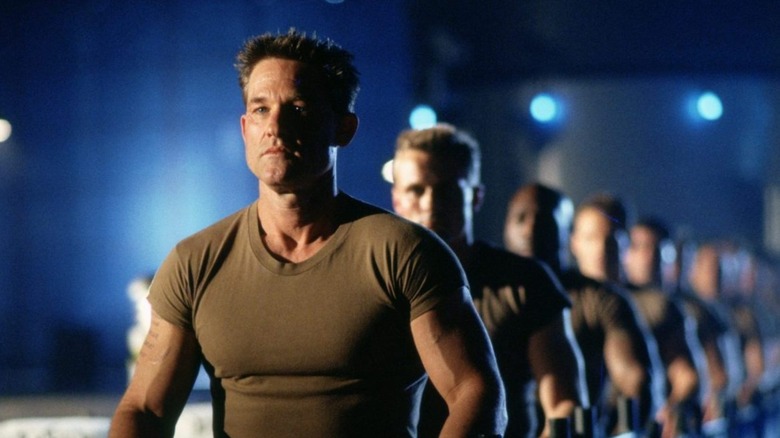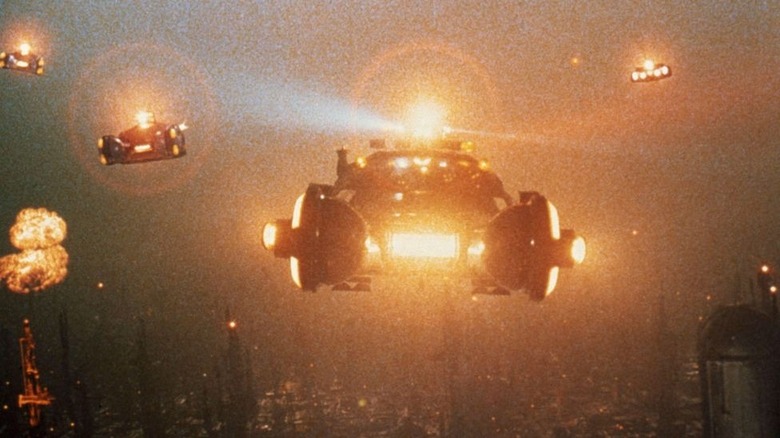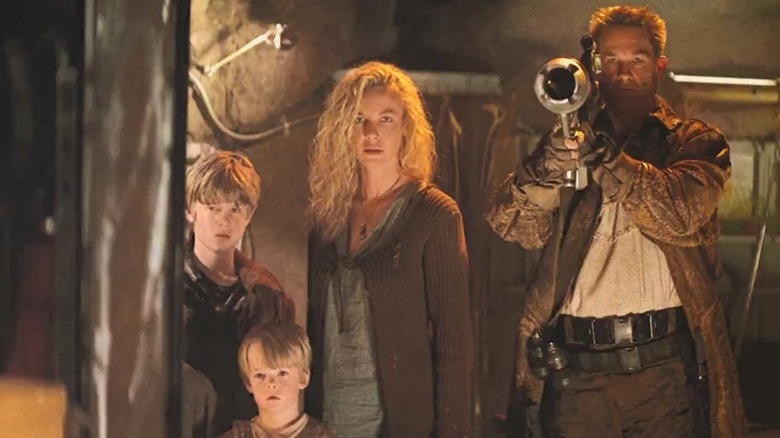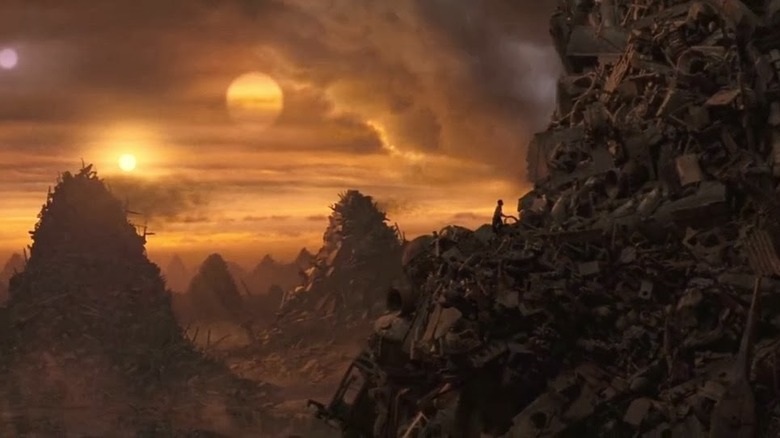Kurt Russell's Soldier Is Considered A Sequel To Blade Runner – But Is It Really?
Shared universes are all the rage now, ever since the domination of the Marvel Cinematic Universe came to pass. But the MCU was hardly the first cinematic venture to willfully connect its disparate characters and franchises — Universal Pictures put their Monsters together as early as 1943's "Frankenstein Meets the Wolf Man," and the movies of filmmakers like John Hughes, Kevin Smith and Quentin Tarantino all have varying degrees of connective tissue.
While all of those are deliberate and concrete examples of extended universe world-building, other movies that feature "Easter egg"-style references and appearances are harder to pin down as being sequels, side-quels, or whatever loose term might apply. One such movie is 1998's "Soldier," a sci-fi action film directed by Paul W.S. Anderson and starring Kurt Russell as Todd, a man trained from birth to be a consummate soldier for an unscrupulous interstellar military force.
The relationship between "Soldier" and 1982's "Blade Runner" isn't just a mere case of headcanon — there are some concrete connections to be found, as well as thematic ones, as illustrated in this piece by Nadine Smith for Little White Lies. Yet the film can't quite be called a fully-fledged sequel to "Blade Runner," especially as doing so would mean that it would open up a weird shared universe can of worms.
He's seen things you wouldn't believe: the Blade Runner connection
The most concrete evidence for "Solider" being a "Blade Runner" sequel begins with both movies sharing a screenwriter: David Webb Peoples. While Peoples co-wrote "Blade Runner" with Hampton Fancher and wrote "Soldier" solo, the films both concern groups of humanoid people bred with the intention for use in combat situations who are to be unquestionably loyal and expendable. Main characters in "Blade Runner" and "Soldier," specifically Rutger Hauer's Roy Batty and Russell's Todd, undergo a spiritual and social awakening when they're left to their own devices. Batty escapes custody and goes on the run with some fellow Replicants, while Todd is literally thrown out with the trash when a new, superior form of super soldier comes along, ultimately finding refuge with refugee human colonists on a trash planet.
According to some dialogue and on-screen monitor graphics, Todd and Roy have shared some battlefields, too. As Todd's dossier indicates, he served in the Battle at Tannhauser Gate as well as the Shoulder of Orion conflict. These locations (and, by extension, their battles) are mentioned during Roy's climactic speech to Rick Deckard (Harrison Ford) in "Blade Runner," with the inference being that Todd's platoon of human soldiers helped Roy's group of Replicants during those skirmishes.
Even more tangible is the appearance of a Spinner, the famous flying car from "Blade Runner," in "Soldier." Right near the colony where Todd is taken in, a defunct Spinner can be seen, implying that the "Soldier" world of 2036 takes place subsequent to the "Blade Runner" world of 2019.
More human than human, but still human
While both "Blade Runner" and "Soldier" ask fundamental questions about the base nature of humanity, the effects of upbringing (or programming) on individuals, and the struggle for human rights, there are important distinctions separating each film on a technical and tonal level. For one thing, Todd and his fellow soldiers are not Replicants; the movie's opening scenes make it clear that Todd and the others are human children who are forcibly selected by the military to become soldiers and then raised and trained for that purpose. By contrast, 2017's "Blade Runner 2049" reveals that Replicants are born in a fully adult state with their programming mostly intact.
Additionally, while "Soldier" and "Blade Runner" both fall ostensibly under the label of science-fiction, the former is a western while the latter is a film noir, with each subgenre coloring how the films explore their themes and characters. "Blade Runner" is a more existentialist, melancholy, and bleak movie, its aim to blur the line between hero and villain, cop and criminal, human and Replicant. The line becomes so blurred that the film famously has multiple endings. "Soldier" is more archetypal and rigidly defined — while Todd's upbringing makes his integration into the colonist community difficult, he's clearly portrayed as a hero who learns to use his talents to protect and serve those he loves. The film is rather nakedly a riff on 1953's "Shane," which also tells the story of a man with a violent nature learning to apply that violence for good.
While there are a number of examples of cinematic universe sequels that change their tonal approach, "Soldier" and "Blade Runner" don't quite blend together smoothly. The combination of the two raises a number of questions about how they would fit with each other: are Todd and his human platoons supplements to Replicants? If Replicants exist, why use humans for combat at all? Such questions aren't touched upon, simply because the films were never meant to be literally connected.
Is Soldier also a sequel to Event Horizon, Escape From New York, and The Computer Wore Tennis Shoes?
When discussing the status of "Soldier" as a sequel to "Blade Runner," one must consider the myriad other easter eggs director Paul W.S. Anderson snuck into the movie, all of which provide as much evidence as the "Blade Runner" nods for potential sequeldom.
Todd's aforementioned dossier contains loads more cheeky references to other sci-fi films, video games, and movies from Kurt Russell's career. The battles of the Nibian Moons Campaign, the Antares Maelstrom War, and the War of Perdition's Flames are all from "Star Trek II: The Wrath of Khan." The Doom MKIV BFG gun Todd is said to use is from the "Doom" video games. The Plissken Patch that Todd is given is a reference to Russell's character from "Escape From New York." The Dexter Riley Award references Russell's character from the trilogy of movies that includes "The Computer Wore Tennis Shoes." What's more, the surface of planet Arcadia 234 contains other famous sci-fi vehicles in addition to the Spinner, including the Lewis & Clark from Anderson's previous movie, "Event Horizon."
Taking all of these references as literal indications that "Soldier" and all those other movies are set within the same universe is ludicrous, so the notion that the film is a literal sequel to "Blade Runner" must also be debunked. Certainly there are a lot of themes and subtext that both movies have in common, yet it's clear that Anderson is not just having a bit of fun with easter eggs, but is also attempting to position "Soldier" as a more archetypal and mythic story. All these references serve that purpose, helping to make the movie more immediate and relatable rather than highlighting its futuristic and remote setting. It's a movie geek's way of saying "once upon a time," setting the story in a nebulous fantasy space where it's a sequel to everything and nothing all at once.



